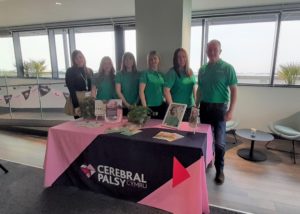Go Green for Cerebral Palsy Awareness Month
March is Cerebral Palsy Awareness Month, which aims to raise awareness of cerebral palsy and help raise funds to support the important work that organisations around the country are doing to support children and their families. Discover more below and how we can help you.
What is cerebral palsy?
Cerebral palsy is the name for a group of lifelong conditions that affect movement and coordination. It is generally caused by damage to the brain that can develop before, during or soon after birth.
Cerebral palsy is the most common physical disability in childhood, with an estimated 30,000 children in the UK living with the condition. There are different types of cerebral palsy that can affect the body, including:
- Spastic – The most common form of cerebral palsy, where the muscles of the body appear stiff and tight.
- Dyskinetic – This form is characterised by involuntary movements.
- Ataxic – This form affects balance and is characterised by shaky movements.
- Mixed – Damage to more than one area of the brain can lead to a mixed presentation of symptoms.
Causes and symptoms
The causes of cerebral palsy include bleeding in the baby’s brain, reduced blood and oxygen supplied to the brain, the brain temporarily not getting enough oxygen during a difficult birth, or an infection caught by the mother during the pregnancy.
There are various symptoms of cerebral palsy, including delays in reaching developmental milestones, for example, not sitting by 8 months or walking by 18 months. Children can also experience weak arms and legs, random uncontrolled movements and a range of other problems. For example, swallowing difficulties, speaking problems, vision problems and learning disabilities.
The severity of these symptoms can vary significantly. Where some people only have minor problems, others may be severely disabled as a consequence of the injury.
Unfortunately, there is currently no cure for cerebral palsy, but treatments are available to help people with the condition lead as active and independent lives as possible. These can include:
- Physiotherapy
- Speech therapy
- Occupational therapy
- Medicine for muscle stiffness and other difficulties and, in some cases, surgery.
Most children with cerebral palsy live into adult life and can live for many decades. The condition, however, may limit their activities and independence. Some children attend a mainstream school, but some may have special educational needs. The problem that’s occurred in the brain does not get worse over time, but the condition can put a lot of strain on the body and can cause problems, such as painful joints, later in life.
Medical negligence claims and how we can help you
Cerebral palsy affects approximately 1 in 10,000 babies born in the UK. Not every child born with cerebral palsy will have an actionable case, but if they do, they can be complex and result in substantial payments in damages if liability is established – easily running into many millions.
As one of the leading UK law firms in this area of Law, we have a proven track record of handling complex and sensitive medical negligence claims. Many of these cases settle without going to court, which is a stress that can be avoided in what is an already extremely difficult time.
If you think your child experienced negligent treatment at, or around, the time of birth that caused a brain injury such as cerebral palsy, then please contact us today for an informal chat about the merits of bringing a claim. You can find contact details for our Medical Negligence team below.
How we’re supporting Cerebral Palsy Awareness Month
To help support Cerebral Palsy Awareness Month, we’ve been working with Cerebral Palsy Cymru to help share information and raise awareness about the condition across the firm, and today, our Medical Negligence team in Cardiff and Education team in London are ‘Going Green’ as part of the campaign by wearing green around our offices. Take a look at the teams below!

